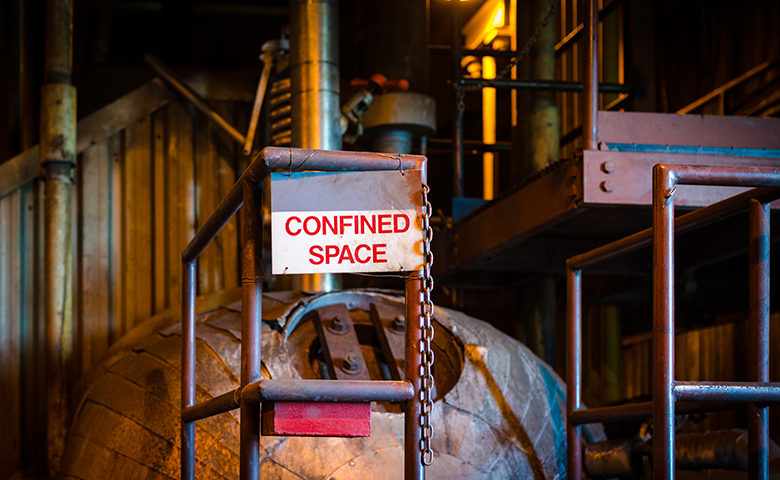Working in tunnels, vats, manholes and other confined spaces requires precautions because these environments have the potential to, among other risks, trap or asphyxiate those inside. Before any work begins in these types of areas, it’s vital to understand the basics of confined spaces safety and to address issues such as hazard recognition, permit requirements, monitoring devices, PPE, and training.
Confined spaces basics
In general, confined spaces are classified as spaces that are large enough for an employee to enter and perform their work. They have limited or restricted means for entry or exit, and are not designed for continuous occupancy.
According to OSHA, non-permit required spaces are confined spaces that fulfill the above criteria but do not contain or have the potential to contain any hazard capable of causing death or serious physical harm. Permit-required confined spaces, on the other hand, in addition to the above characteristics also contain one or more of the following:
- a potentially hazardous atmosphere;
- a substance or material with the potential for engulfing the worker;
- inwardly converging walls or a floor that slopes downward and tapers to a smaller cross-section;
- any other recognized serious safety or health hazard.
There are many things to consider before working in these environments, not least because permit-required confined spaces also make rescue and self-rescue more difficult than they would be in ordinary circumstances.
The rest of this blog post will touch on these issues. But keep in mind that this is only a quick flyover of safety concerns regarding confined spaces, and for a more comprehensive understanding you should consult safety regulators and/or a qualified safety expert.
Hazard recognition
In any workplace situation, it’s important to spend an appropriate amount of time on hazard recognition. And it’s especially necessary when it comes to planning to work in confined spaces.
- A proper risk assessment must be performed to identify potential hazards.
- If hazards are identified, they require a pre-entry checklist.
- If the checklist confirms the hazards (or the potential for hazards), a permit must be filled.
- An entry supervisor and an attendant are then required to participate to ensure worker safety.
Monitoring devices
Monitoring devices can confirm safe working conditions or warn of an unsafe environment. They can save people’s lives, and their correct use and understanding are important to safe operations.
- Test for flammable gases and vapors, and potential toxic air contaminants before allowing anyone to perform work inside the confined space. Toxic gas hazards vary depending on the space and it’s important to remember that carbon monoxide is not the only hazard to check for.
- Test for safe oxygen levels and remember that even if they’re safe now, they can quickly change.
- Ensure that monitoring devices receive regular maintenance. Employees have to be comfortable with performing a bump-test and calibrating their gas monitors.
Personal protective equipment
PPE is required in almost all confined spaces. As a result, employers need to provide workers with the right type of PPE and with relevant training to ensure that the equipment is maintained well and used correctly.
- All workers (not only the ones working inside confined spaces) must understand the necessary equipment (e.g., respirators, gloves, harnesses) and know how to use it correctly.
- Everyone has to be familiar with the use of lifelines and other lifting equipment in the event of an emergency.
Training
Confined spaces training must be thorough, meet OSHA requirements and emphasize hazard control procedures. It should educate employees on all different types of dangers they may encounter in a confined space, and teach them how to recognize and react to them.
- The training content should depend on the type of industry and work, and on the specific regulations that apply to the jurisdiction.
- Employers can help their workers develop an automatic response to certain situations through practice and drills.
- Workers have to be taught how to use and maintain PPE and rescue equipment.
- Employers must provide CPR/first aid training and organize an annual drill to practice these skills during a permit space rescue practice. Although only one employee on site needs to have CPR/first aid training, it’s always a good idea to make this training available to everyone.
- Ensure that workers are comfortable with atmosphere monitors by providing proper training and refresher classes. People who are not comfortable with a tool are less likely to use it well or at all.
Introducing human factors training into the company’s safety program is also a good idea. Human errors can easily occur when a person’s headspace makes it hard for them to concentrate on the job. Addressing this problem can help workers get their mind back on task when they feel frustrated or rushed, for example. When working in confined spaces, the more people understand their own state of mind, the safer they are likely to be.
Employers must know the regulations and understand what is expected of them and of their employees when faced with confined spaces. To ensure everyone’s safety, they must ensure proper hazard recognition and provide workers with reliable equipment, PPE, and with thorough and regular training. Ignoring or underinvesting in even one of these could be a deadly mistake.

